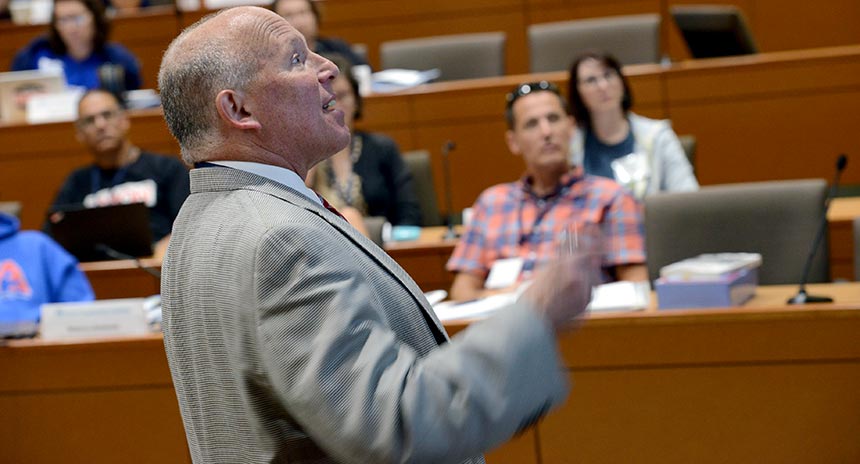What’s in a Labor Day weekend? There is the history of soil and toil, grit and memory. There is knowledge that women used to stand outside factories with baseball bats to ward off those who might injure their husbands, who were inside on sit-down strikes demanding decency in pay, safety and treatment. There are the memories of workers who died in protest of horrendous working conditions.
There is knowledge that because of workers’ courageous and risky efforts, there exists unemployment insurance, child labor laws, health insurance, pensions and benefit plans, better working conditions and improved work weeks.
And today, there is also knowledge that the fight is far from over.
“There is stunning economic inequality,” said Harold Eisenstein, a NYSUT lawyer and labor activist. In 1979, the average salary in the U.S. was $44,500. In 2018, the average salary is — $44,500. Today, most workers do not earn a pension, and many people work two or three jobs. Some are without health insurance, leaving them “one step away from bankruptcy.”
The labor movement began making serious noise in the early 1930s.
“Their weapon was to strike,” Eisenstein said. “They were well informed; they knew that the union stood for them. Together they could fight the boss.”
Democracy and a well-informed membership were keys to successfully changing working conditions, Eisenstein said. Unions had one steward for every 10 employees. They had allies from the community and workers from other industries. Their actions were bold and brought on by the necessity of needing living wages and safer working conditions.
There were casualties. In 1934, two workers were shot during the San Francisco 83-day waterfront strike. That same year, police charged the crowd during the Minneapolis Trucking Strike resulting in tremendous violence. During the 1937 steel strike in Chicago, 10 workers were shot.
The workers persisted because it was the only way to get fair contracts and to make a decent living for themselves and their families, Eisenstein explained.
Employers struck back. In 1939, the Supreme Court banned sit-down strikes. Following that, sympathy strikes were outlawed, as well as secondary boycotts. Individual states were allowed to pass “right-to-work” laws.

Eisentein presents on labor history to participants of NYSUT's New Local Presidents Conference in August. Photo by El-Wise Noisette.
“In right-to-work states, the wages are lower, the job opportunities are fewer,” said Eisenstein. Twenty-one percent more people are without health insurance.
But newer movements are encouraging the press forward. Teacher unions are getting more public support and in West Virginia, Arizona and other right-to-work states, planned strikes have brought out thousands of educators and supporters to stop the conscientious defunding of public education
“It doesn’t happen spontaneously,” Eisenstein said. “It requires members to be active in their unions, to build support in the community and to stand together against their employer’s attacks.”
He called on workers to remember the words of Martin Luther King Jr.:
"At the turn of the century women earned approximately ten cents an hour, and men were fortunate to receive twenty cents an hour. The average work week was sixty to seventy hours. During the thirties, wages were a secondary issue; to have a job at all was the difference between the agony of starvation and a flicker of life. The nation, now so vigorous, reeled and tottered almost to total collapse. The labor movement was the principal force that transformed misery and despair into hope and progress. Out of its bold struggles, economic and social reform gave birth to unemployment insurance, old age pensions, government relief for the destitute, and above all new wage levels that meant not mere survival, but a tolerable life. The captains of industry did not lead this transformation; they resisted it until they were overcome. When in the thirties the wave of union organization crested over our nation, it carried to secure shores not only itself but the whole society."
Why are unions and working people under constant attack?